
Mueller M.R. - Fundamentals of Quantum Chemistry[c] Molecular Spectroscopy and Modern Electronic Structure Computations (Kluwer, 2001)
.pdf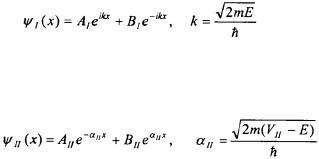
106 Chapter 5
The probability that the particle will tunnel to Region III depends on the mass of the particle, the width of the potential barrier a, and the difference in the energy of particle to the potential of the barrier. Figures 5-4a and 5-4b shows the tunneling probability of an electron and a proton with a kinetic energy of 1 eV  encountering a potential barrier of 2 eV of varying width. To put the values in Figures 5-4a and 5-4b into perspective, the diameter of an atom is on the order of 0.2 nm; hence, the tunneling ability of the electron and proton are great at the atomic scale. It can also be seen in Figures 5-4a and 5-4b that the greater the mass of the particle, the less likely the particle is to tunnel into Region III. As the energy of the particle approaches the energy of the potential barrier, the tunneling probability increases as shown in Figure 5-5.
encountering a potential barrier of 2 eV of varying width. To put the values in Figures 5-4a and 5-4b into perspective, the diameter of an atom is on the order of 0.2 nm; hence, the tunneling ability of the electron and proton are great at the atomic scale. It can also be seen in Figures 5-4a and 5-4b that the greater the mass of the particle, the less likely the particle is to tunnel into Region III. As the energy of the particle approaches the energy of the potential barrier, the tunneling probability increases as shown in Figure 5-5.
So far the potential barrier (Region II) has been of finite width. Another important type of system to consider is one in which the potential barrier is of infinite thickness such as in a particle striking armor plating. If a particle is unable to tunnel due to an infinitely thick potential barrier, there will most likely be some significant penetration at the atomic scale of the particle into the potential barrier.
To analyze the penetration ability of a particle into an infinitely thick potential barrier, a new hypothetical system is considered as shown in Figure 5-6. The system is similar to a Particle-in-a-Box, however, the potential at 
 is finite and greater than the energy of the particle. The potential at
is finite and greater than the energy of the particle. The potential at 
 is infinite containing the particle to the positive x-axis. The potential is zero in Region I, and Region II extends from
is infinite containing the particle to the positive x-axis. The potential is zero in Region I, and Region II extends from 
The general wavefunction for Region I will be same as in the previous systems discussed in this Section.
Since  the general wavefunction for Region II will be the same as in Equation 5-40.
the general wavefunction for Region II will be the same as in Equation 5-40.
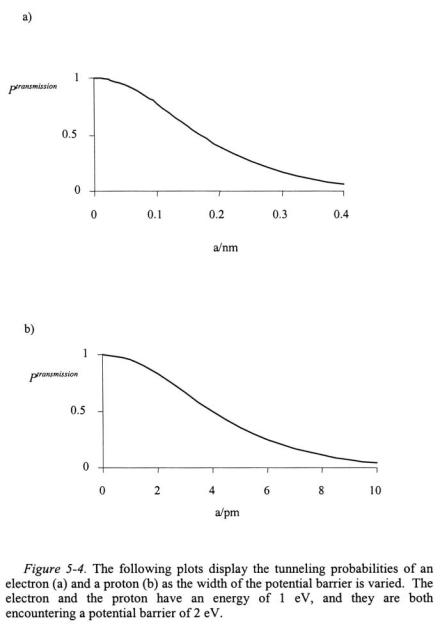
Particles Encountering a Finite Potential Energy |
107 |
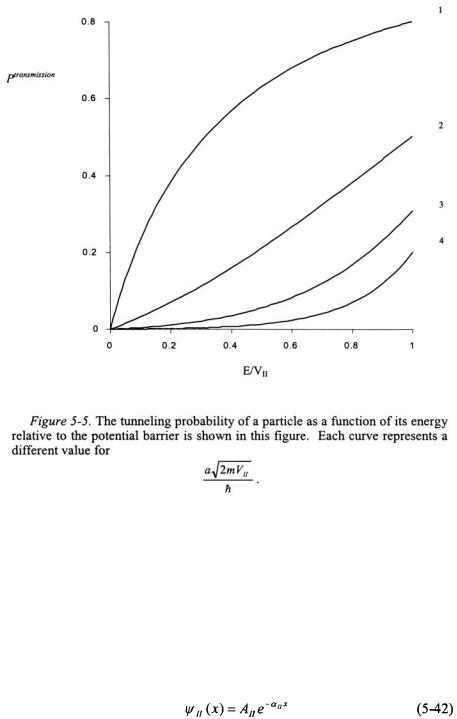
108 |
Chapter 5 |
The wavefunction for Region II contains an exponentially increasing component as x increases. As x approaches infinity, the wavefunction in Region II will approach infinity. This is an untenable result based on the Born interpretation - the probability density of the particle will approach infinity as wavefunction approaches infinity. Since this is not physically possible, the positive exponential component of the wavefunction must be discarded.
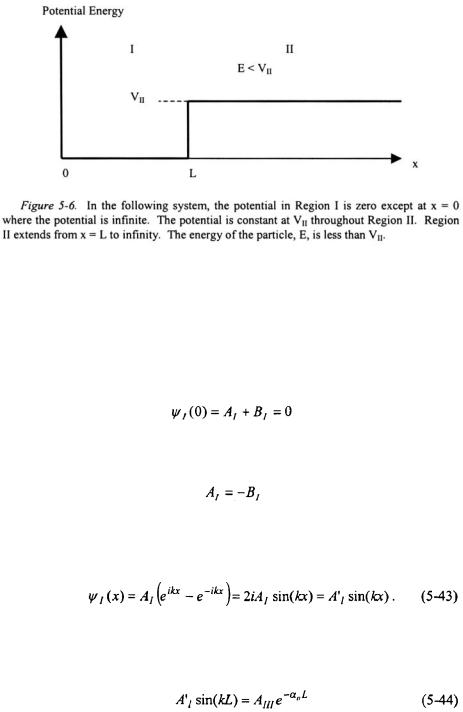
Particles Encountering a Finite Potential Energy |
109 |
Since the potential is infinite at  the wavefunction for the particle at this point must also equal to zero.
the wavefunction for the particle at this point must also equal to zero.
or
This reduces the wavefunction for the particle in Region I to the following expression:
The continuity conditions can now be applied to the wavefunctions for Regions I and II at  This results in the following expressions.
This results in the following expressions.
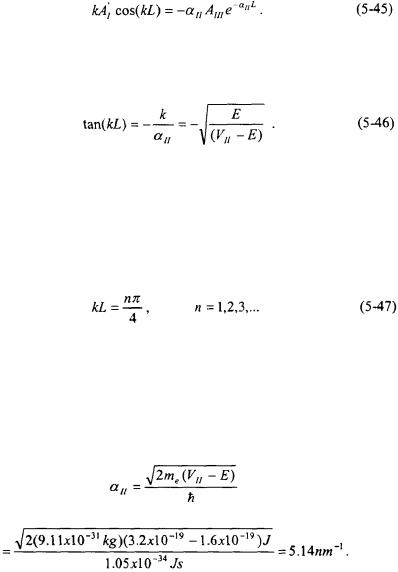
110 |
Chapter 5 |
and
If Equation 5-44 is divided by Equation 5-45, the following expression results:
Equation 5-46 indicates that only certain energies relative to  will result in penetration of the particle into Region II. For instance, if
will result in penetration of the particle into Region II. For instance, if  then tan(kL) will be nearly zero indicating essentially no penetration. Maximum penetration will occur for terms of kL that are positive integers of
then tan(kL) will be nearly zero indicating essentially no penetration. Maximum penetration will occur for terms of kL that are positive integers of  resulting in tan(kL) equal to one.
resulting in tan(kL) equal to one.
To put the penetration ability of particles into perspective, consider an electron that is accelerated across a potential difference of 1 Volt. The electron now has a kinetic energy, E, of 1 eV 
 The electron approaches an infinitely wide potential barrier,
The electron approaches an infinitely wide potential barrier,  of an opposing 2 Volts
of an opposing 2 Volts  The term
The term  is computed as follows:
is computed as follows:
Since the energy of the particle is half of the potential energy of the barrier,  To obtain the maximum penetration of the particle, Equation 5-47 is applied where n is equal to one.
To obtain the maximum penetration of the particle, Equation 5-47 is applied where n is equal to one.
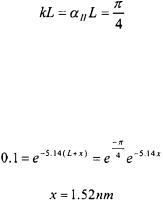
Particles Encountering a Finite Potential Energy |
111 |
Since  we wish to determine at what distance
we wish to determine at what distance  that the wavefunction has diminished, for the sake of illustration, to 0.1 of its value at
that the wavefunction has diminished, for the sake of illustration, to 0.1 of its value at 
The diameter of an atom is on the order of 0.2 nm indicating that the electron is capable of penetrating a depth of approximately 8 atoms. As this example portrays, the penetration of particles can have important effects on surface processes such as electrodes, heterogeneous catalysis, or any other process that occurs at the atomic scale.
PROBLEMS AND EXERCISES
5.1) Determine the wavefunction for the  of the harmonic oscillator using (a) Equation 5-9 and (b) using Equation 5-10.
of the harmonic oscillator using (a) Equation 5-9 and (b) using Equation 5-10.
5.2) Determine the following for a harmonic oscillator in the  state:
state:
(a) the average kinetic energy, (b) the average potential energy, (c) the average momentum, and (d) the average position of the mass. How do the quantum mechanical results compare to that for a classical system?
5.3) Calculate the probability of the particle in a harmonic oscillator to be beyond the classical turning point for the  state.
state.
5.4) Apply the harmonic oscillator Hamiltonian to the  wavefunction and verify that it is an eigenfunction.
wavefunction and verify that it is an eigenfunction.

112 |
Chapter 5 |
5.5) For a harmonic oscillator in the ground-state, determine  and
and  How does the value of
How does the value of  compare to the Heisenberg Uncertainty Principle?
compare to the Heisenberg Uncertainty Principle?
5.6) Locate the nodes for harmonic oscillator for the state 
5.7) The normal bond length,  for an HI molecule is approximately 161 pm. The force constant of the bond is 313.8 N/m. What is the probability that the bond will be 10% greater if the molecule is in (a) the ground-state and (b) in the
for an HI molecule is approximately 161 pm. The force constant of the bond is 313.8 N/m. What is the probability that the bond will be 10% greater if the molecule is in (a) the ground-state and (b) in the  excited state?
excited state?
5.8) The harmonic oscillator is an approximation to describing the vibrational motion between atoms in a bond. The Morse potential is a more accurate description. The first-correction to the potential is of the following form:
whereby g is a constant. Determine the first-order correction to the energy for a harmonic oscillator in the ground and first excited states.
5.9) Determine the maximum penetration depth of a proton that is in the same system as described in Figure 5-6. The energy of the proton is  and the potential barrier is
and the potential barrier is 
5.10) Make a plot similar to Figure 5-3b but instead for an electron encountering an opposing potential of 2 eV. How does mass effect the reflection probability?
Chapter 6
Vibrational/Rotational Spectroscopy of Diatomic
Molecules
This chapter focuses on applying the fundamentals of quantum mechanics developed in the previous chapters to interpreting the vibrational and rotational transitions that occur within diatomic molecules in infrared spectroscopy. Analysis of an infrared spectrum of a diatomic molecule results in structural information about the molecule and the energy differences between the molecule’s vibrational and rotational eigenstates.
6.1 FUNDAMENTALS OF SPECTROSCOPY
Molecular spectroscopy is a means of probing molecules and most often involves the absorption of electromagnetic radiation. The absorbed electromagnetic radiation results in transitions between eigenstates of a molecule. The type of eigenstates involved in a transition depends on the energy of the radiation absorbed. Figure 6-1 shows an electromagnetic spectrum along with the relative energies, wavelengths, and frequencies associated with each type of radiation. Absorbed ultraviolet and visible radiation generally results in transitions amongst electronic eigenstates. Absorbed infrared radiation results in changes in vibrational and rotational eigenstates. Absorbed microwave radiation results in changes in rotational eigenstates. The specific wavelengths of radiation that are absorbed in each region of the electromagnetic spectrum depend on the energy difference
113
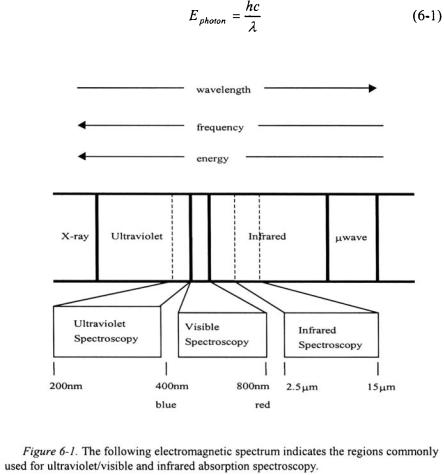
114 Chapter 6
between the eigenstates of a molecule. As an example, a diatomic molecule with a “stiff” bond will absorb at a higher energy photon (shorter wavelength) than another diatomic molecule with a less “stiff” bond. The absorbed radiation in a spectrum provides information on the energy differences amongst various eigenstates of a molecule; however, it does not provide any information on the actual eigenstates involved in the transitions. Quantum mechanics is needed in order to analyze a spectrum in terms of assigning an absorption in a spectrum to a specific transition in eigenstates of a molecule.
The energy of a photon of electromagnetic radiation is inversely proportional to its wavelength, 
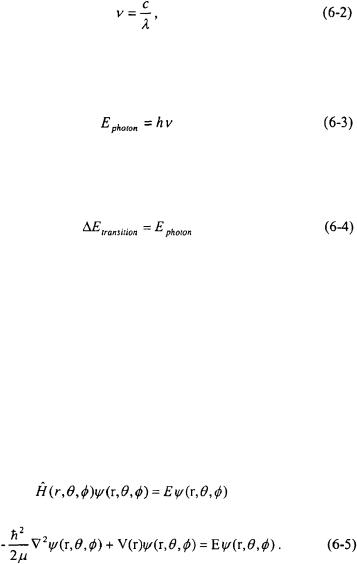
Vibrational/Rotational Spectroscopy of Diatomic Molecules |
115 |
The h in Equation 6-1 is Planck’s constant and c is the speed of light. The wavelength of the photon absorbed in the infrared region is recorded in micrometers (microns,  ) or in terms of wavenumbers
) or in terms of wavenumbers  In microwave Spectroscopy, the spectrum is recorded in terms of the frequency,
In microwave Spectroscopy, the spectrum is recorded in terms of the frequency,  of the radiation. The frequency of the radiation is determined as follows:
of the radiation. The frequency of the radiation is determined as follows:
and has the units of  or Hertz, Hz. The energy of the photon is determined by multiplying the frequency by Planck’s constant, h.
or Hertz, Hz. The energy of the photon is determined by multiplying the frequency by Planck’s constant, h.
The energy of the photon absorbed is equal to the energy difference between the eigenstates of a molecule.
6.2 RIGID ROTOR HARMONIC OSCILLATOR APPROXIMATION (RRHO)
Consider the vibration and rotation of a diatomic molecule. Since the molecule is rotating in space, the Hamiltonian is best written in terms of spherical coordinates. The potential V(r) depends only on the separation of the atoms, and it develops from the electrons and the chemical bonding that occurs between the atoms. The Schroedinger equation for a rotating and vibrating diatomic molecule is
